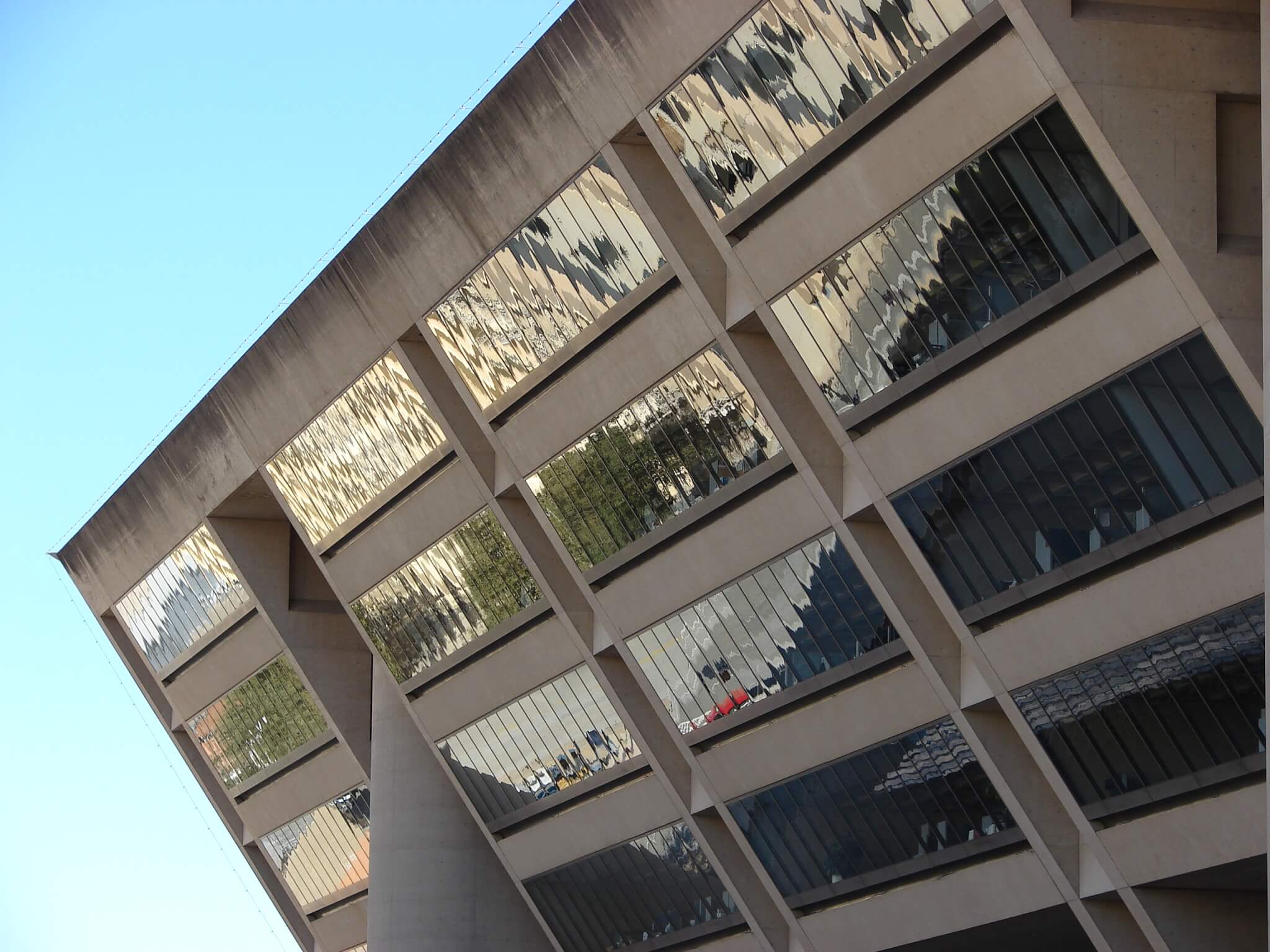The camera pans across a sun-bleached Texas Plaza, concrete rising in bold diagonal planes toward the sky. In the 1980s, the image stood for a dystopian future, one where power leaned precariously over the public. Long before it was cast as a movie villain, Dallas City Hall served as a monument of civic faith.
Designed by I. M. Pei and completed in 1978, the inverted pyramid of raw concrete was a bold architectural gesture. The Brutalist building’s tilted facade and vast forecourt were conceived to project transparency, openness, and redemption at a time when the city was reeling from President Kennedy’s assassination.
Now, that symbol of renewal faces potential demolition.
At a Crossroads
Later this month, Dallas City Council will begin debating whether to repair, sell, or demolish the 47-year-old landmark. Decades of deferred maintenance, ranging from water leaks to failing electrical systems, have left the building in disrepair. Fixing it could cost as much as $100 million, while city budgets have allotted a fraction of that amount to municipal maintenance.
Some city leaders, like Dallas City Council Member Chad West, argue that selling the property could open up prime downtown land for redevelopment, possibly a new arena for the Dallas Mavericks. Others see the proposal as a betrayal of the very ideals the building was designed to embody.
“This is a significant part of downtown Dallas’ cultural fabric,” historic preservationist Ron Siebler told the Dallas Morning News. “Doing away with a historic building to create an arena is an extremely Dallas way of doing business.”
Deferred Maintenance
When Dallas City Hall opened in 1978, the city was still grappling with the legacy of the Kennedy assassination and the national stigma that followed. Then-mayor Erik Jonsson wanted a civic building that would embody a new kind of Dallas—confident, modern, and humane.
Pei responded with a vision that was both monumental and human-scaled. The building’s sloped form gives the illusion of motion. Its deep overhang shades the plaza, creating a sense of shelter in the Texas heat. Inside, the Great Court, a skylit atrium nearly 250 feet long and 100 feet tall, floods with daylight, emphasizing connection rather than hierarchy.
Pei described architecture as “a reflection of society.” Dallas City Hall embodied that belief, translating the democratic ideals of transparency and accessibility into monumental form.
Time and neglect have not been kind. Water leaks threaten the building’s foundation. Elevators stick between floors. A broken pipe earlier this year flooded the council chambers. City records show at least $60 million in known repairs are needed, with another $40 million in potential costs yet to be fully assessed.

Push For Preservation
Dallas City Hall’s massive concrete volumes taper with geometric precision, creating a visual equilibrium between authority and approachability. The plaza, meant as a gathering space for protests, parades, and civic rituals, was one of the first attempts in Dallas to make government physically accessible.
Now, the plaza is often empty, its fountains dried and openness is mistaken for vacancy. Council member Paula Blackmon, who supports restoring the building, calls the neglect a civic failure. “We’ve done more harm to it than good,” she said. “We haven’t taken care of it, and it’s sad.”
Others see opportunity in restoration. Preservationists point to Boston’s recently landmarked City Hall as proof that midcentury civic architecture can be rehabilitated.
“I cannot find any major commission of [Pei’s] that has been lost to history yet,” Reagan Rothenberger of the Dallas Landmark Commission said in the Dallas Morning News after the commission voted unanimously in March to pursue landmark protection for City Hall. “I hope Dallas does not have the distinction of being the first.”
Dallas City Hall’s looming concrete form may not be universally loved, but it remains instantly recognizable. As the city grows denser, wealthier, and more privatized, the building’s stoic presence feels almost radical. It’s a reminder of when Dallas tried to build for its citizens, not its investors.
Dallas City Council’s finance committee will meet on October 21 to determine the future of I. M. Pei’s architectural landmark.
→ Continue reading at The Architect's Newspaper
